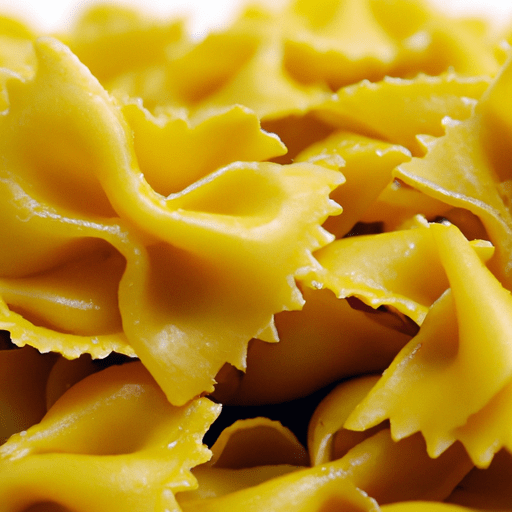Cooked Farfalle Tonde: A Delicious Twist to Your Pasta Experience
Pasta lovers, prepare to be amazed! In today’s post, we’ll be diving into the delightful world of cooked farfalle tonde. With its unique bow-tie shape, delicate texture, and versatile nature, this Italian pasta has gained popularity worldwide. Whether you’re a novice in the kitchen or a seasoned cook, this pasta will undoubtedly add a touch of elegance to your culinary creations. So let’s explore the taste, cooking techniques, nutritional value, and fascinating history of cooked farfalle tonde!
Taste and Texture: A Harmony of Delicate Flavors
When cooked to perfection, farfalle tonde boasts a delectable marriage of flavors and textures. Its classic, al dente bite provides a satisfying chew, while the smooth surface allows sauces and other ingredients to cling effortlessly. The taste is subtle and light, with a mild nuttiness that pairs wonderfully with a variety of ingredients. This versatility makes farfalle tonde an ideal choice for both simple and elaborate pasta dishes.
Common Uses: Elevate Your Culinary Creations
Thanks to its unique shape, farfalle tonde shines in a wide range of dishes. Its whimsical bow-tie appearance adds a touch of whimsy and sophistication to any plate. Here are some common uses in cooking:
- Saucy Pastas: Farfalle tonde excels in dishes with robust and chunky sauces, such as tomato-based sauces with diced vegetables or ragù. The nooks and crannies of the pasta capture the sauce, enhancing every bite.
- Pasta Salads: The delicate shape of farfalle tonde makes it a fantastic choice for pasta salads. Its texture holds up well when mixed with crisp vegetables, tangy dressings, and savory proteins.
- Delicate Cream Sauces: Creamy sauces with subtle flavors, like Alfredo or lemon cream sauce, complement the gentle taste of cooked farfalle tonde beautifully. The pasta’s elegant shape adds visual appeal to these dishes.
Nutritional Value: A Wholesome Option
Beyond its enchanting taste and versatility, cooked farfalle tonde offers some nutritional benefits. Made from durum wheat semolina, it provides essential carbohydrates, a good energy source for an active lifestyle. Additionally, it is low in fat and sodium, making it a healthier choice compared to certain other pasta varieties. Remember, portion control is key to maintaining a balanced diet.
History and Interesting Facts: Tying It All Together
The origin of farfalle tonde can be traced back to the Lombardy region in northern Italy. The word “farfalle” means butterflies, drawing a poetic connection to the pasta’s distinctive shape. While the exact origin story remains mysterious, it is believed that the bow-tie design emerged in the early 16th century. Farfalle tonde exemplifies the essence of Italian culinary artistry, combining simplicity, elegance, and sophistication on the plate.
Cooked farfalle tonde is every pasta lover’s dream come true. Its delicate taste, versatile nature, and enchanting bow-tie shape make it a perfect addition to your culinary repertoire. Whether you’re creating saucy pasta dishes or exploring the refreshing realm of pasta salads, this marvelous pasta will elevate your cooking experience. So go ahead, embrace the whimsical beauty of cooked farfalle tonde, and savor every delightful bite!
Note: Remember to experiment with various sauces and ingredients to unleash the full potential of this remarkable pasta.
Cooked Farfalle Tonde
Origin: Farfalle Tonde, also known as bowtie pasta, originated in Northern Italy. The name “farfalle” comes from the Italian word for butterflies, as the shape of the pasta resembles a butterfly or bowtie.
Common Uses: Cooked farfalle tonde is commonly used as a versatile pasta that pairs well with a variety of sauces, both creamy and tomato-based. It is often used in pasta salads, baked pasta dishes, or served as a side dish. Its unique shape helps to catch and hold onto sauces, making it a popular choice for many pasta dishes.
Nutritional Benefits: Cooked farfalle tonde is a good source of carbohydrates, providing energy for the body. It also contains some dietary fiber, which supports digestive health. Additionally, it is low in fat and sodium, making it a healthier option compared to some other pasta shapes.
Unique Properties: The unique shape of farfalle tonde allows it to hold onto sauces and ingredients, ensuring each bite is full of flavor. The ridges and ruffled edges of the pasta help capture and hold onto the sauce. This shape also provides a pleasing texture to dishes.
Historical Significance: While the exact origins of farfalle tonde are not well-documented, pasta shapes resembling farfalle have been recorded back to the 16th century. Throughout history, pasta has played a significant role in Italian cuisine, and the popularity of farfalle tonde has grown worldwide due to its distinctive shape and versatility in various recipes.




Use the share button below if you liked it.
It makes me smile, when I see it.